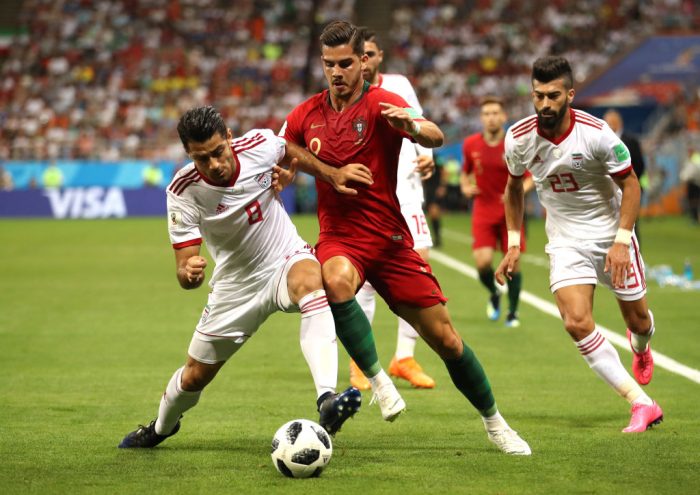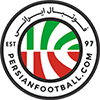Fox Sports: AFC Best XI [Opinion]

SARANSK, RUSSIA - JUNE 25: Andre Silva of Portugal is challenged by Ramin Rezaeian and Morteza Pouraliganji of Iran during the 2018 FIFA World Cup Russia group B match between Iran and Portugal at Mordovia Arena on June 25, 2018 in Saransk, Russia. (Photo by Clive Mason/Getty Images)
Fox Sports Asia – HONG KONG, With just the one match remaining to determine the 2018 World Cup champion and with Asia’s involvement long since ended, FOX Sports Asia looks back at how the continent’s five nations fared in selecting our Best XI from amongst the AFC participants.
Given that they were Asia’s sole representatives in itssecond round it’s little surprise that Japan dominates our 4-2-3-1 setup with the underperforming Saudi Arabian side the only nation not to have a player in the Best XI.
A mix of younger players and experienced veterans these are the players that stood out from an Asian perspective with four of those players at domestic teams on the continent with the remainder playing their trade in Europe.
GOALKEEPER: CHO Hyun-woo (Korea) – Hardly a lock to even be the number one heading into the tournament at a position of real depth for Korea, Cho’s efforts in Russia have almost certainly assured that he’ll be the long-term solution to a role that’s seen a revolving cast of starters in recent years.
Having caught the eye in his nation’s first two matches, it was his heroics in the shock win over Germany that cemented his status as one of the best keepers in the tournament as he repelled shot after shot in earning man of the match honours against the dethroned World Champions.
RIGHT BACK: Hiroki SAKAI (Japan) – Both Japanese fullbacks were outstanding in getting through an absolute mountain of work across four matches in energy-sapping conditions – conditions that saw Sakai struggling through the final quarter of an hour against Belgium with cramp but still providing metronomic runs up and down the right touchline with quality crosses and some superb tracking tackles.
CENTRAL DEFENDER: Mark MILLIGAN (Australia) – Having spent the latter part of his career primarily as a central midfielder, the vastly experienced Milligan was asked to drop back into a central defensive role in Russia and in typical fashion went about that task with a minimum of fuss, maximum effort and stood out for a disappointing Australian side with the ease of his distribution from the back, positional and organizational sense.
CENTRAL DEFENDER: Morteza POURALIGANJI (Iran) – Following the shock late omission of Jalal Hosseini much attention – and pressure – was thrust on the Qatari-based defender and he rose to the challenge superbly alongside an equally impressive performer in young Majid Hosseini. Clinical in his interceptions, sharp in his positioning and movement and with the ability to bring the ball forward from his central post, the 26-year-old showed he’s a fine heir to Hosseini’s long-serving role as the defensive rock for Team Melli.
LEFT BACK: Yuto NAGATOMO (Japan) – As with Sakai on the right, Nagatomo was an outstanding contributor on the left where he created numerous chances getting in behind his man or cutting back towards the box and was also wonderful in his positioning and defensive work.
RIGHT MIDFIELDER: SON Heung-min (Korea) – The one knock on the consensus leading Asian footballer (who swept almost every pan-Asian award again this year) is that he often doesn’t deliver the kind of performances for his country that he does for his club side. That’s a valid criticism here once again but what’s undeniable is that he can still provide the polish when needed and he iced the German win coolly and also scored two of the three goals that Korea grabbed at the finals.
CENTRAL MIDFIELDER: Gaku SHIBASAKI (Japan) – Under the previous Japan coach he was hardly even a squad regular but with Akira Nishino at the helm, Shibasaki finally delivered on what’s always been seen as immense promise. The kind of deeper playmaker whose movement makes it difficult for defenders to track him, he displayed an outstanding passing range – both short and long – that allowed the more advanced Japan players to shine whilst also being a strong defensive presence.
CENTRAL MIDFIELDER: Omid EBRAHIMI (Iran) – An unsung star in an Iranian side full of such players, Ebrahimi has struggled to become a first team regular but the 30-year-old was superb for Team Melli in having to perform a variety of different roles and functions, often within the single match. Shuffling between the #6 and #8 roles and also on occasion playing almost as a shadow striker, the Al Ahli man was consistent in both breaking up play and being a vital link between defence and attack in a side that was under constant pressure in all three group matches.
LEFT MIDFIELDER: Takashi INUI (Japan) – It’s surprising to see the 30-year-old being termed a breakout star given he’s been on the scene for many years but this was undoubtedly his finest hour in the national shirt. A constant threat both from his wide station on the left and when he cut inside, he also scored against both Senegal and Belgium and was a standout performer throughout.
ATTACKING MIDFIELDER: Shinji KAGAWA (Japan) – Another oft-maligned star who turned back the clock during the past couple of weeks in Russia. From being a bit-part player in the buildup to the World Cup to then emerging as the undisputed number ten for Japan, his early penalty against Colombia set the team on its way and he was a persistent creative threat for this impressive Japanese side.
FORWARD: Yuya OSAKO (Japan) – Perhaps not the player to emerge as a long-term solution to Japan’s ongoing battle to find a prolific striker, the recently-inked SV Werder Bremen man nonetheless a genuine handful for opposing defences and it was his ability to link up with the midfield three as well as creative chances for those deeper runners that was behind much of Japan’s success in Russia.


 (5 votes, average: 4.60 out of 5)
(5 votes, average: 4.60 out of 5)

